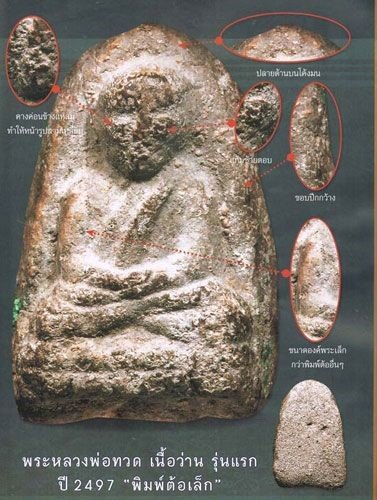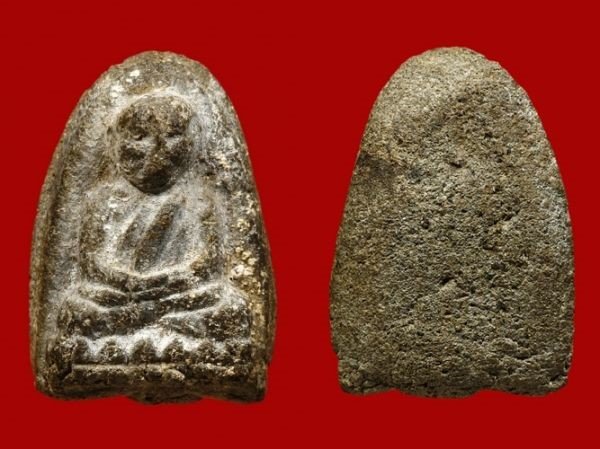General Characteristice of Phra Luangpu Thuad 1st batch B.E. 2497 (Group of Herb Content)1. Amulet colors are brown black or black grey. Some are fine-grained content and smooth, some are coarse-grained content and rough. Black is from sacred black clay or call in Thai “Kak Ya Yak” which was appeared throughout the piece and clear powder also is seen. The amulets shape is not stable but could be noticed obviously. We can see the red dot similar to Dok Pikul (bullet flower)l in the content. Actually materials composition are · Brown from herb 108 types · Red or orange dot from red pollen (see picture)
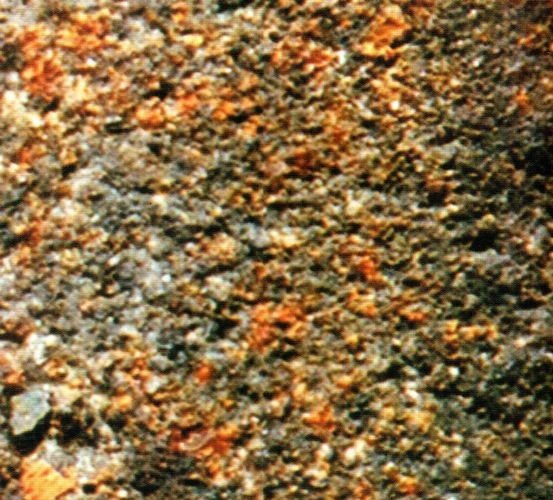 · Black from sacred black clay from cave (Kak Ya Yak) · Sticky rice and Tung oil as cement · Yellow from forest banana · White from lime and sacred powder · Black and shine ray from mineral powder 2. Dry and soft white powder from driven off herb powder (Herb sap) and lime covers the skin.3. The amulet skin if which one never been used or touched by sweat, there was called "Piew Derm" the color is black or dark brown. In some amulets, the herb sap was appeared in white color same as mangosteens sap. The white powder also appeared and covered allover image Buddha body.
· Black from sacred black clay from cave (Kak Ya Yak) · Sticky rice and Tung oil as cement · Yellow from forest banana · White from lime and sacred powder · Black and shine ray from mineral powder 2. Dry and soft white powder from driven off herb powder (Herb sap) and lime covers the skin.3. The amulet skin if which one never been used or touched by sweat, there was called "Piew Derm" the color is black or dark brown. In some amulets, the herb sap was appeared in white color same as mangosteens sap. The white powder also appeared and covered allover image Buddha body.  4. The sacred grained black soil or call in Thai “Kak Ya Yak” was appeared throughout the piece and white powder from lime and sacred powders are clearly seen.
4. The sacred grained black soil or call in Thai “Kak Ya Yak” was appeared throughout the piece and white powder from lime and sacred powders are clearly seen.  5. On the back side or some part of amulets, we can see coarse-grained mineral embedded in the skin. It's black and shine ray but not in every piece.
5. On the back side or some part of amulets, we can see coarse-grained mineral embedded in the skin. It's black and shine ray but not in every piece.
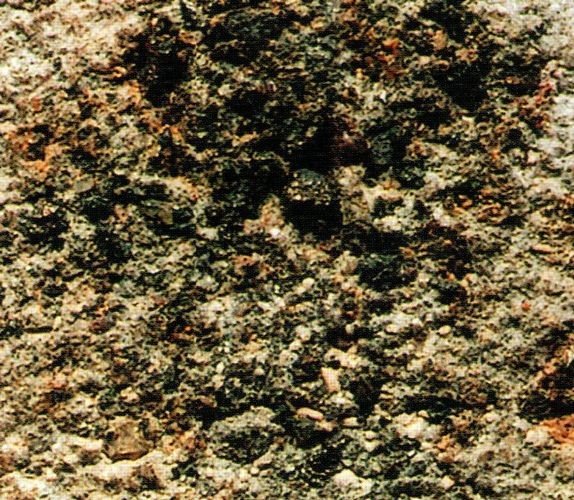 6. Some amulet has a hole under the base. This hole's shape is square but not in every piece. 7. The amulets edge is slightly rolled inner. 8. The fingerprint was appeared on the edge of some amulets base. 9. On the back side of amulet appeared in both of slightly convex and plain styles 10. The amulets skin should be dried and look soft, not fresh as a newly made.
6. Some amulet has a hole under the base. This hole's shape is square but not in every piece. 7. The amulets edge is slightly rolled inner. 8. The fingerprint was appeared on the edge of some amulets base. 9. On the back side of amulet appeared in both of slightly convex and plain styles 10. The amulets skin should be dried and look soft, not fresh as a newly made.
 Nowadays, there are a lot of the faked amulets, because this amulet was well known in the holiness such as bringing charity good will, good luck, invulnerable and good to be begged for any wishes.Mould of Phra LuangPu Thuad B.E.2497 1. Pim Sie Lieam (Square) or Pim Klak Mai Kheed (match box) In B.E. 2497 (A.D.1954), Wat Changhai by the Phra Arjam Tim with the cooperation of Mr. Anan Khananurak team. They operated and prepared the ceremony to build first amount of Phra LuangPhu Thuad Nua Wan (Herbs content). In the same time, a priest named Thavom Thammaviriyo who stayed at wat Changhai at that time. He saw the priest man bringing the tuberous plants power to press into the amulets crucibles and take off the amulets until the ceremony completed. He was inspired by the powder in the crucible after ceremony. He want to make some souvenir to give for the newly priests in the same, so he made an amulets block same as Phra LuangPhu Thuad Phra Arjam Tim. He made one more amulet to paste on the backside of amulet. (His attention is to make it for memory monument of his priesthood at wat ChangHai.) At that time he collected some tuberous herbs powder from the crucibles made by Phra Arjam Tim. He brought that powder to press in the crucible he made himself. But the amulets were just a few quantities and cannot be specified it's amount.
Nowadays, there are a lot of the faked amulets, because this amulet was well known in the holiness such as bringing charity good will, good luck, invulnerable and good to be begged for any wishes.Mould of Phra LuangPu Thuad B.E.2497 1. Pim Sie Lieam (Square) or Pim Klak Mai Kheed (match box) In B.E. 2497 (A.D.1954), Wat Changhai by the Phra Arjam Tim with the cooperation of Mr. Anan Khananurak team. They operated and prepared the ceremony to build first amount of Phra LuangPhu Thuad Nua Wan (Herbs content). In the same time, a priest named Thavom Thammaviriyo who stayed at wat Changhai at that time. He saw the priest man bringing the tuberous plants power to press into the amulets crucibles and take off the amulets until the ceremony completed. He was inspired by the powder in the crucible after ceremony. He want to make some souvenir to give for the newly priests in the same, so he made an amulets block same as Phra LuangPhu Thuad Phra Arjam Tim. He made one more amulet to paste on the backside of amulet. (His attention is to make it for memory monument of his priesthood at wat ChangHai.) At that time he collected some tuberous herbs powder from the crucibles made by Phra Arjam Tim. He brought that powder to press in the crucible he made himself. But the amulets were just a few quantities and cannot be specified it's amount.Mr.Thavom added that when Phra Arjam Tim knew this story he did not obstruct. But also supported and told him to make the amulets by virgin mind. Phra Arjarn Tim also took these amulets pronounce incantantion ceremony in the same of as Phra Nua Wan(herb) in first period in B.E. 2497. After ceremony he gave the amulets to his priest friends and took some to give for several senior committees. LuangPu Thuad Wat ChangHai B.E. 2497 Pim Sie Lieam were scarcely found since numbers of creation were no more than 100 pieces. 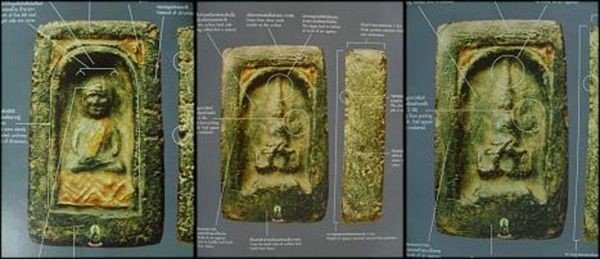 2. Pim Kammakarn ( Giving to committees) Phra Luangphu Thuad Pim Jak Kammakam. The characteristic is very close to Phra Pim Yai. It was also recognized to be one type of Pim yai. It's well known by calling "Phra Pim Kammakarn". This is a popular type among collectors. The details of this amulet is fine and clearer than Phra LuangPhu Thuad Nua Wan (herb) in B.E. 2497. Because of the differences in many parts so, there could not be integrated to Pim Yai. The amulets mass were also fine more than other moulds. And the importance of this mould were created in the limited amount. Phra Pim Kammakam was divided into: 2.1 Phra Pim Kammakarn A (committee A): This image face is round, large, short chin, full cheeks and thick lips. The line of priest’s robe on the shoulder is convex and clear. The body is robust. Content texture is fine-grained due to high composition of sacred black soil (Kak Ya Yak). Dark brown, red dot and white powder are clearly seen.
2. Pim Kammakarn ( Giving to committees) Phra Luangphu Thuad Pim Jak Kammakam. The characteristic is very close to Phra Pim Yai. It was also recognized to be one type of Pim yai. It's well known by calling "Phra Pim Kammakarn". This is a popular type among collectors. The details of this amulet is fine and clearer than Phra LuangPhu Thuad Nua Wan (herb) in B.E. 2497. Because of the differences in many parts so, there could not be integrated to Pim Yai. The amulets mass were also fine more than other moulds. And the importance of this mould were created in the limited amount. Phra Pim Kammakam was divided into: 2.1 Phra Pim Kammakarn A (committee A): This image face is round, large, short chin, full cheeks and thick lips. The line of priest’s robe on the shoulder is convex and clear. The body is robust. Content texture is fine-grained due to high composition of sacred black soil (Kak Ya Yak). Dark brown, red dot and white powder are clearly seen. Unique sign of LuangPhu Thuad - Heabage - Committe A 1. There are lines below eyes. 2. There is light collar bone (none for some amulets) 3. Small robe hangs through the left hand. 4. Small split surface line is at the hand. 5. Left shin has extra mass. 6. The back side is little bended. 7. The backside has lightly finger press (but none for some amulets because of oldess. 8. The backside has small red dots.
 2.2 Phra Pim Jak Kammakarn B (comittee B): Amulet texture is similar to Pim Kammakarn A. The diference is detail lines on body which are not sharp and clear as the first mould.
2.2 Phra Pim Jak Kammakarn B (comittee B): Amulet texture is similar to Pim Kammakarn A. The diference is detail lines on body which are not sharp and clear as the first mould.
Unique sign of LuangPhu Thuad - Herbage - Committee B
1. Forehaead curve out. 2. Left temple more hollow in than the right side. 3. Right shoulder looks larger than another one. 4. A line is on the robe. 5. Right arm is larger. 6. The backside has lightly finger press (but none for some amulets because of oldess) 7. The backside has small red dots and gravel from minerals. 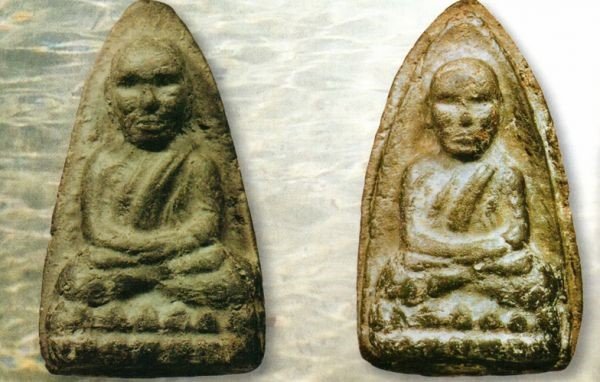 3. Pim Yai (Big mould)3.1 Pim Yai A ( Pim Yai Hua Kheed or Lining on head) The amulet has the large face and big body.The forehead is convexed, cheeks are clear, the chin is nearly square shape, feet and knees are big and thick. Between first and second tier of lotus base is deep groove. Mould differentiation is a scratching mark on left temple of head.
3. Pim Yai (Big mould)3.1 Pim Yai A ( Pim Yai Hua Kheed or Lining on head) The amulet has the large face and big body.The forehead is convexed, cheeks are clear, the chin is nearly square shape, feet and knees are big and thick. Between first and second tier of lotus base is deep groove. Mould differentiation is a scratching mark on left temple of head.
 Notification points are 1. Red powder from herb pollen is appeared. 2. Small coarse-grained minerals are scattered at backside. Texture of mineral is matt black not shiny, inside is white-pale yellow (The shiny is fake amulet) Unique sign of LuangPhu Thuad - Herbage - Large size "A' Lining on head 1. Left temple has a clear split surface line. 2. Upper right ear has extra mass. 3. Left brow has a small hollow. 4. There is an extra mass on background. 5. A split surface line is at arms. 6. A split surface line is at breast cloth. 7. A split surface line is at balm. 8. There is extra mass under the right knee. 9.The backside has lightly finger press (but none for some amulet because oldess) 10. The backside has small red dots.
Notification points are 1. Red powder from herb pollen is appeared. 2. Small coarse-grained minerals are scattered at backside. Texture of mineral is matt black not shiny, inside is white-pale yellow (The shiny is fake amulet) Unique sign of LuangPhu Thuad - Herbage - Large size "A' Lining on head 1. Left temple has a clear split surface line. 2. Upper right ear has extra mass. 3. Left brow has a small hollow. 4. There is an extra mass on background. 5. A split surface line is at arms. 6. A split surface line is at breast cloth. 7. A split surface line is at balm. 8. There is extra mass under the right knee. 9.The backside has lightly finger press (but none for some amulet because oldess) 10. The backside has small red dots. 
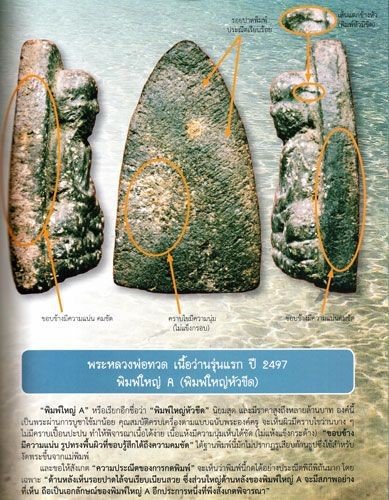 3.2 Pim Yai B (Pim Yai Luek) This amulet has the large face big body. From head, body, lap until lotus base are deeply convexed. The body looks elegant and bigger than other moulds.
3.2 Pim Yai B (Pim Yai Luek) This amulet has the large face big body. From head, body, lap until lotus base are deeply convexed. The body looks elegant and bigger than other moulds. 
 3.3 Pim Yai C (Pim Yai C Lai Jud or Dot Shoulder) The general characteristics look like Pim Yai. But there is a clue over the left shoulder. A small piece of over mass is appeared on the shoulder obviously.
3.3 Pim Yai C (Pim Yai C Lai Jud or Dot Shoulder) The general characteristics look like Pim Yai. But there is a clue over the left shoulder. A small piece of over mass is appeared on the shoulder obviously.
 Unique sign of LuangPu Thuad - Herbage - Large size "C" 1. Left shoulder has extra mass like dot, bring to generation's name. 2. Right background is rough. 3. Background has smaller curve out than Pim Yai A 4. Left elbow has extra triangle mass. 5. The backside has lightly finger press (but none for some amulets because of oldess) 6. The backside has small red dots.
Unique sign of LuangPu Thuad - Herbage - Large size "C" 1. Left shoulder has extra mass like dot, bring to generation's name. 2. Right background is rough. 3. Background has smaller curve out than Pim Yai A 4. Left elbow has extra triangle mass. 5. The backside has lightly finger press (but none for some amulets because of oldess) 6. The backside has small red dots.  4. Pim Klang (Middle mould)
4. Pim Klang (Middle mould) Earlier, Phra LuangPhu Thuad B.E. 2497 was classified into Pim Yai, Pim Klang, Pim Lek, Pim Tor and Pim Tuen. But in the present, the reclassified for clearance and easily understanding. They were divided into Pim Yai, Pim Kammakam, Pim Klang and Pim Phra Rod and Pim Tor. Phra Pim Yai is still same as the previous but divided into ordinary Pim Yai and Pim Kammakarn. Phra Pim Klang, Pim Tuen, both were integrated into Phra Pim Klang which will be mentioned later. Phra Pim Lek in present time is Pim Phra Rod and Pim Tor. This is the norm to classify the present amulets for the same understanding. Please notice that the most of amulets face is not clear. 4.1 Pim Klang Yai: The body is similar to Phra Pim Yai B but the size is smaller.

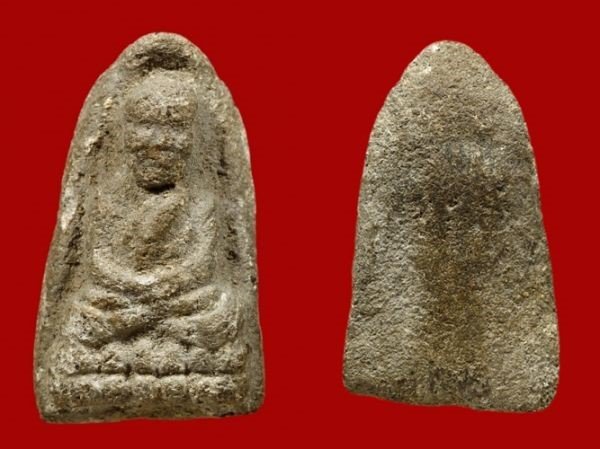 4.2 Pim Klang Luek (Middle size and deeply convex body) Unique sign of LuangPu Thuad - Herbage - Pim Klang Luek 1. Oval face. 2.. Wide body and more shallow than "Large size" 3. Left arm and elbow extended. 4. Petal of the lotus blossoms are smaller than "Large size". 5. The backside has lightly finger press (but none for some amulets because oldess) 6. The backside has small red dots.
4.2 Pim Klang Luek (Middle size and deeply convex body) Unique sign of LuangPu Thuad - Herbage - Pim Klang Luek 1. Oval face. 2.. Wide body and more shallow than "Large size" 3. Left arm and elbow extended. 4. Petal of the lotus blossoms are smaller than "Large size". 5. The backside has lightly finger press (but none for some amulets because oldess) 6. The backside has small red dots.

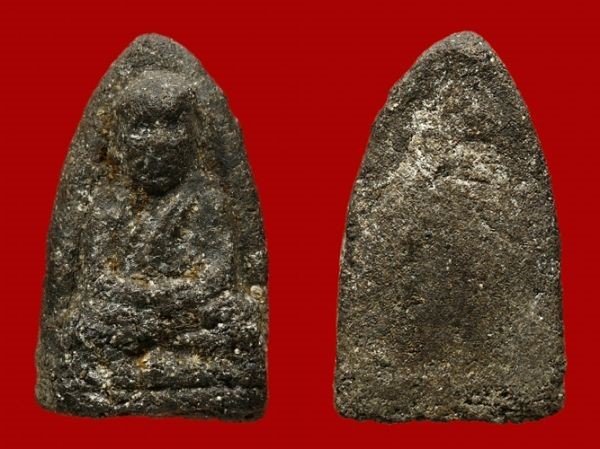 4.3 Pim Klang Luek Nah Nohk (Middle size with convexed forehead)
4.3 Pim Klang Luek Nah Nohk (Middle size with convexed forehead)
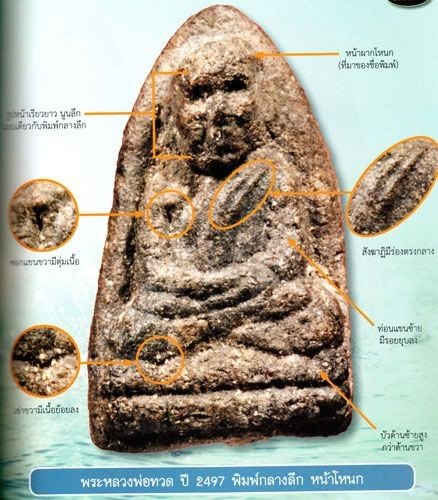 4.4 Pim Klang Luek Nah Yai A (Middle size with big face type A)
4.4 Pim Klang Luek Nah Yai A (Middle size with big face type A)
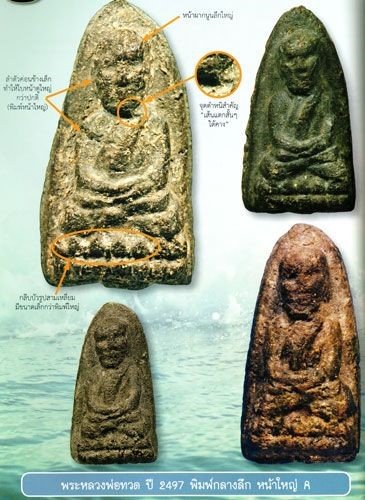
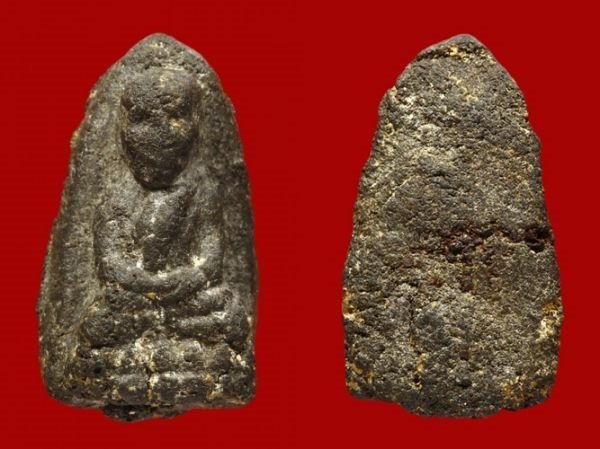 4.5 Pim Klang Luek Nah Yai B (Middle size with big face type B)
4.5 Pim Klang Luek Nah Yai B (Middle size with big face type B)  4.6 Pim Klang LookTa (Middle size with eyeballs)
4.6 Pim Klang LookTa (Middle size with eyeballs)
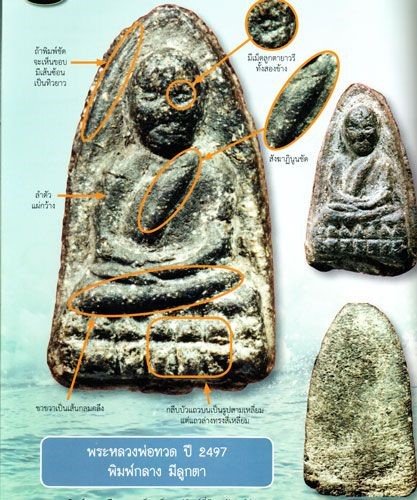 4.7 Pim Klang NahKrom (Middle size with rounded oval face)
4.7 Pim Klang NahKrom (Middle size with rounded oval face) 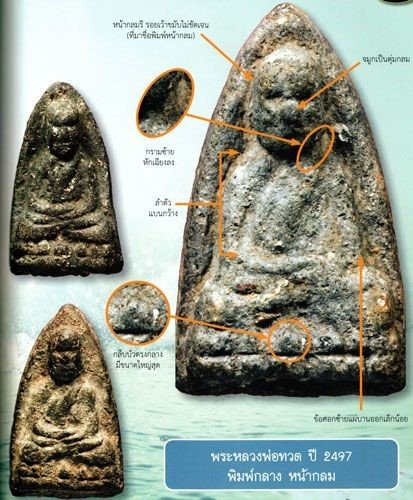
 4.8 Pim Klang Ok-Fab (Middle size with flat chest)
4.8 Pim Klang Ok-Fab (Middle size with flat chest) 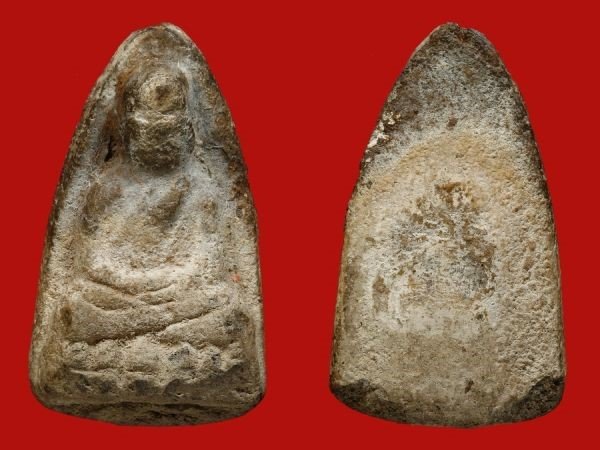 4.9 Pim Klang Chalude (Middle size with tall body)
4.9 Pim Klang Chalude (Middle size with tall body)
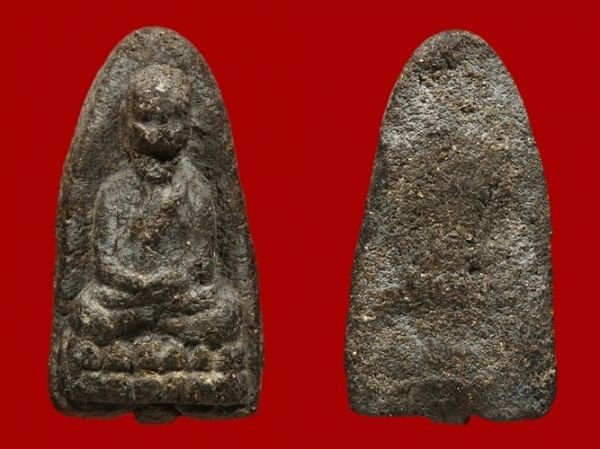 5. Pim Phra Rod LuangPhu Thuad Pim Phra Rod is the smallest size among every pim in Phra LuangPhu Thuad family Wat Changhai which created in B.E. 2497 This mould was built in the big amount of this family but the popularity is not less than other moulds. It may be the name of which was recognized in their holiness. The difference from other mould is top of head is curved in dome shape. LuangPhu Thuad Pim Phra Rod was divided by the characteristic into: 5.1 Phra Rod Pim Yai (Hua Kheed) The face is bigger than Phra Rod in other pim. There is a scratching mark beside head. The face shape is short. The body is bigger and robuster than other moulds.
5. Pim Phra Rod LuangPhu Thuad Pim Phra Rod is the smallest size among every pim in Phra LuangPhu Thuad family Wat Changhai which created in B.E. 2497 This mould was built in the big amount of this family but the popularity is not less than other moulds. It may be the name of which was recognized in their holiness. The difference from other mould is top of head is curved in dome shape. LuangPhu Thuad Pim Phra Rod was divided by the characteristic into: 5.1 Phra Rod Pim Yai (Hua Kheed) The face is bigger than Phra Rod in other pim. There is a scratching mark beside head. The face shape is short. The body is bigger and robuster than other moulds.  Unique sign of LuangPhu Thuad - Herbage - Pim Phra Rod Yai 1. Ball face, no ear. 2. Big eyes. 3. Extra mass at the robe. 4. Petal of the lotus blossoms are pentagon. 5. The backside has lightly finger press (but none for some amulets because of oldess) 6. The backside has small dots.
Unique sign of LuangPhu Thuad - Herbage - Pim Phra Rod Yai 1. Ball face, no ear. 2. Big eyes. 3. Extra mass at the robe. 4. Petal of the lotus blossoms are pentagon. 5. The backside has lightly finger press (but none for some amulets because of oldess) 6. The backside has small dots.

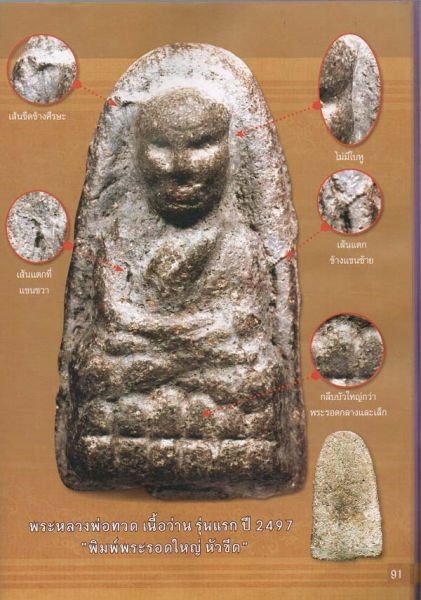
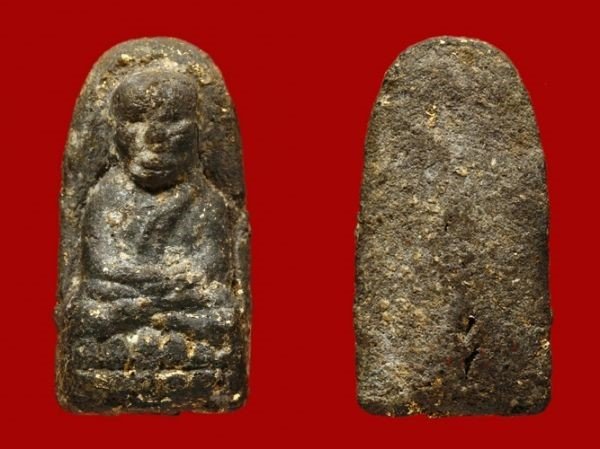
5.2 Phra Rod Pim Kammakam (Phra Rod Committee). The overall characteristic is similar to Pim Kammakarn A. Lip is thick and big (the upper lip is curved down). The difference is the face of this amulet looks like an Indian. The collectors called this characteristic “Apache face” it’s mentioned to a ditch on the cheeks. Unique sign of LuangPu Thuad - Herbage - Pim Phra Rod Committee 1. Ball face. 2. Big eyes and scratched line underneath 3. Extra mass at the robe. 4. Petal of the lotus blossoms are pentagon. 5. The backside has lightly finger press (but none for some amulets because of oldess) 6. The backside has small dots. 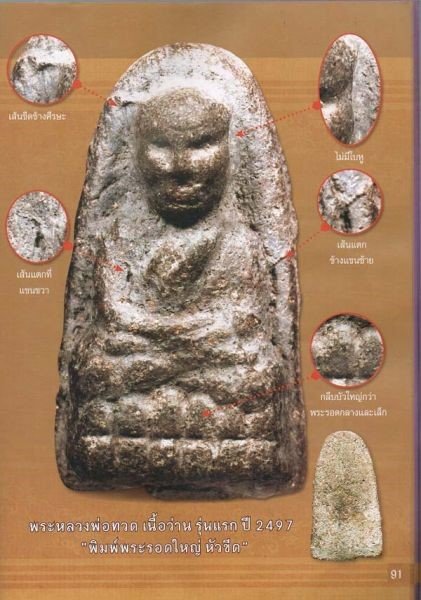

5.3 Phra Rod Pim Klang (Middle size)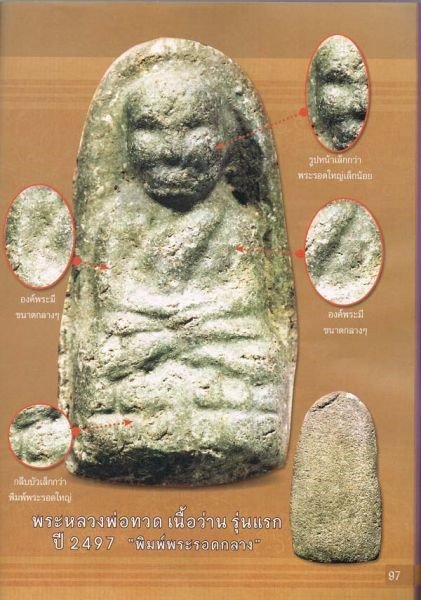
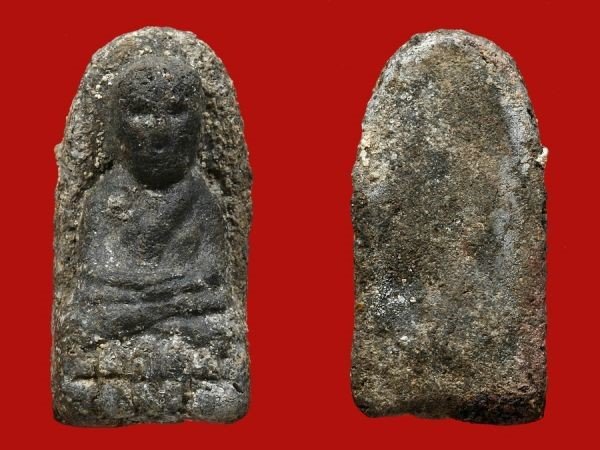 5.4 Phra Rod Pim Lek. The collectors called this mould “owl face”. The face is smaller than other moulds. The details of the face are not clear. The body is smaller and thinner.
5.4 Phra Rod Pim Lek. The collectors called this mould “owl face”. The face is smaller than other moulds. The details of the face are not clear. The body is smaller and thinner. 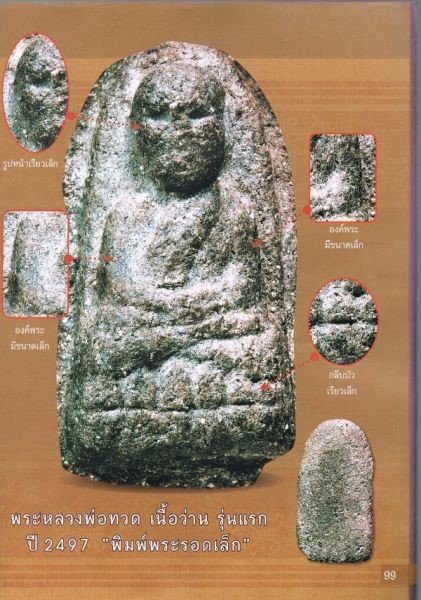
 6. Pim Tor (short mould)
6. Pim Tor (short mould)
The difference from other mould is top of head is curved in dome shape, body is short and wider than other moulds. There are divided into 3 sub moulds by size differentation.
6.1 Pim Tor Yai (Big size) There are 2 sub moulds 6.1.1 Pim Tor Yai Bua Trong (Straight Lotus Base)  6.1.2 Pim Tor Yai Bua Chieng (Slope Lotus Base from right to left)
6.1.2 Pim Tor Yai Bua Chieng (Slope Lotus Base from right to left)
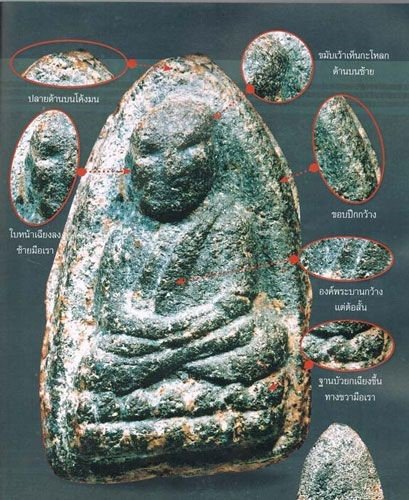 6.2 Pim Tor Klang (Middle size)
6.2 Pim Tor Klang (Middle size)
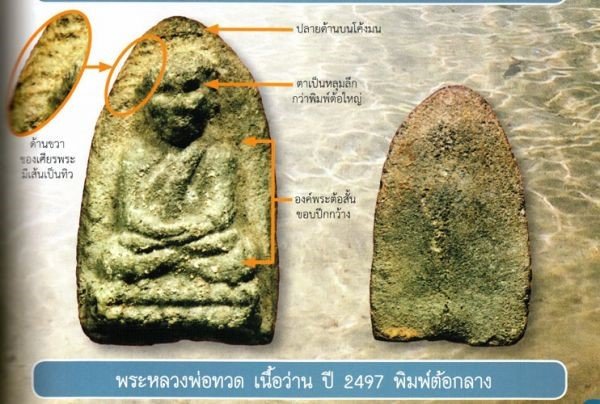
 6.3 Pim Tor Lek (small size)
6.3 Pim Tor Lek (small size)











































